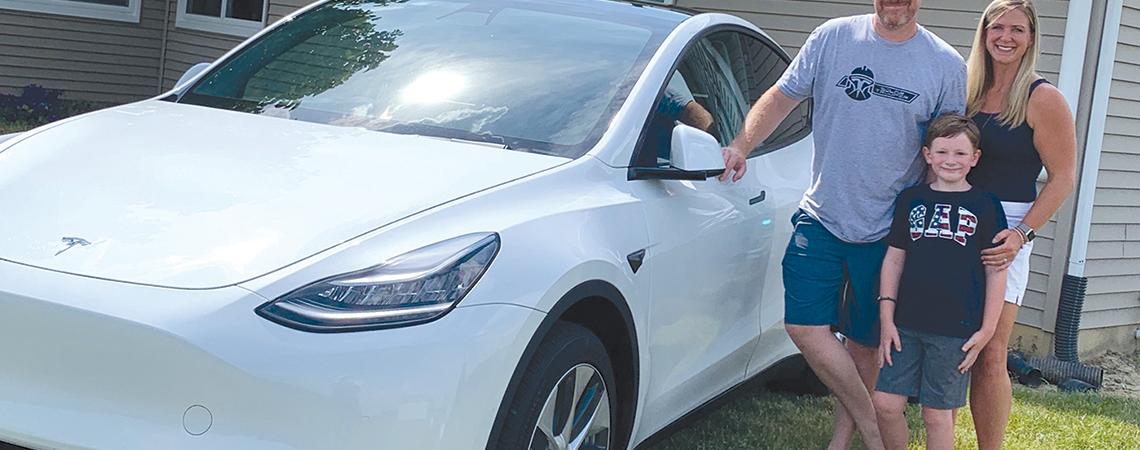Joey and Kristin Huber have been considering — consciously and subconsciously — the benefits of electricity for some time.
Joey, who teaches STEM classes in the Dublin City School District, has numerous aspects of electricity included in his curriculum, but his interest goes deeper than that.
“I have an uncle in North Carolina who really got me thinking about what all we use electricity for and a lot of other things that we can and even maybe should use electricity for,” Joey says. “He put up solar panels and now has all the electric tools and toys that they can power. It got me thinking about that myself, and I’m convinced that’s where society is moving.”
The Hubers, who are members of Marysville-based Union Rural Electric Cooperative, installed solar panels on their house that they now use to charge their recently purchased Tesla Model Y, a fully electric vehicle with a nearly 400-mile range that can recharge about 150 miles of range in only 15 minutes. They took advantage of a rebate offer from URE to help pay for the charger installed at their home. The family also owns an electric bicycle and uses rechargeable battery-powered implements such as a string-trimmer and blower for yardwork.
The Huber family used a rebate from their electric co-op to help purchase a Tesla Model Y.
The Hubers are part of a growing number of people taking advantage of the benefits of using more electricity as part of a strategic plan to save money and reduce environmental impact. That, in turn, improves their quality of life and helps the stability of the entire electric grid.
For example, the simple act of replacing a gas-powered lawnmower with one that uses a rechargeable battery means no more gas cans to fill and store in a garage, no fumes or smoke, and no worries that the mower just won’t start when you pull the cord. Electric mowers are also quieter, so you can avoid those dirty looks from neighbors when you decide to mow early on a weekend morning.
From there, the benefits go global. An idle mower plugged in for recharging becomes part of the electric grid. The more electricity users plugged in and charging during times when people are using the least amount of electricity — probably overnight — the less stress on the grid during the day. That would allow electric utilities to operate more efficiently, evening out electricity use over a 24-hour period — which also helps control costs.
More immediately, for those concerned about the environmental effects of their energy use, electricity is a future-looking choice. “If you look at a national scale, electricity is being generated in cleaner, more efficient ways all the time,” says Ben Wilson, manager of power delivery engineering for Buckeye Power, which supplies electricity to all 24 Ohio electric cooperatives. “That means that every device that uses electricity — from cars to clock radios — will become even better for the environment over time as the electricity it uses gets greener.”
That energy trend is part of what led to one of the nation’s leading environmental groups becoming part of the beneficial electrification movement. In 2018, the National Resources Defense Council (NRDC) published a report outlining a broad plan to significantly reduce greenhouse gas emissions over the next 30 years. A key part of that plan called for using electricity for a bigger share of our energy consumption — a lot more. The group wants to increase electricity’s contribution to all end-use energy from about 20% today to 45% in 2050.
“We’re to the point, especially with our panels, where we save quite a bit of money by using electricity for as much as we can,” Huber says. “We also have a 7-year-old son, and this helps us feel good about trying to ensure a healthy environment for his future. That’s really the best part about it.”
To learn more about using solar energy in your home, visit OhioSolar101.com.
Did you know?
Electricity is much cheaper than gasoline or diesel fuel, costing about $1.20 per gallon (of gasoline equivalent) at a nationwide average.
All-electric vehicles are about three times more efficient than those powered by internal combustion engines and have earned EVs top spots on FuelEconomy.gov’s list of most efficient vehicles. Most are rated at more than 100 miles per gallon (equivalent).










